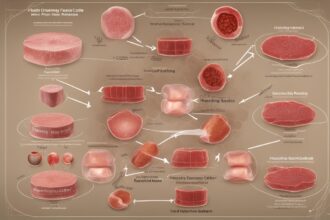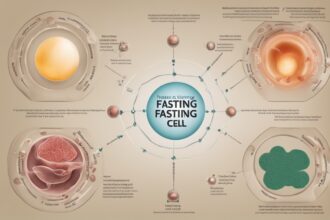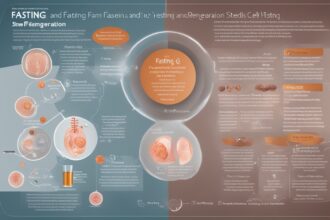Hey there, fasting enthusiasts! If you’ve been searching for a fasting guide that dives deep into the science behind fasting and its incredible effects on the body, you’re in the right place. Today, we’re exploring a fascinating topic: the connection between fasting and stem cells. Fasting isn’t just about weight loss or detoxing—it’s a powerful tool that may enhance your body’s natural repair mechanisms through stem cell activation. Whether you’re new to fasting or a seasoned pro, this post will break down the latest research, offer practical tips for your fasting journey, and explain how this practice could rejuvenate your health at a cellular level. Let’s dive into the science and benefits of fasting for stem cell regeneration!
What Are Stem Cells and Why Do They Matter?
Before we get into how fasting plays a role, let’s talk about stem cells. These are the body’s master cells, capable of transforming into various cell types like muscle, nerve, or blood cells. They’re essential for tissue repair, growth, and regeneration. As we age, our stem cell activity naturally declines, which can slow down healing and contribute to age-related diseases. That’s why scientists are so excited about ways to boost stem cell function—and fasting might just be one of the most accessible methods. Research suggests that fasting can trigger protective and regenerative processes in the body, potentially revitalizing stem cell activity (Longo & Mattson, 2014). In this fasting guide, we’ll unpack how this works and why it’s a game-changer for health.
How Fasting Influences Stem Cell Regeneration
So, how does skipping meals or following a structured fasting plan impact stem cells? When you fast, your body enters a state of metabolic stress, which sounds bad but is actually beneficial in small doses. During fasting, energy resources are redirected from growth and reproduction to maintenance and repair. Studies show that prolonged fasting—typically 24 to 72 hours—can reduce levels of a protein called IGF-1, which is linked to aging and disease, while promoting stem cell regeneration (Cheng et al., 2014). This process helps clear out damaged cells and encourages the production of new, healthy ones. For anyone following a fasting routine, this could mean improved immune function and tissue repair over time. Pretty cool, right?
One landmark study found that fasting cycles in mice led to a significant increase in hematopoietic stem cells, which are responsible for creating new blood and immune cells (Cheng et al., 2014). While human studies are still ongoing, early evidence suggests similar effects, making fasting a promising tool for cellular health. As part of your fasting plan, understanding these mechanisms can help you appreciate the deeper benefits beyond just feeling lighter or more energized.
Types of Fasting for Stem Cell Benefits
Not all fasting methods are created equal, especially when it comes to stem cell activation. If you’re crafting a fasting schedule with regeneration in mind, here are some approaches backed by science that might work for you. Remember, the goal is to induce that mild stress response without overdoing it, so always consult a healthcare provider before starting any intense fasting regimen.
- Prolonged Fasting: Lasting 2–5 days, often with water only or minimal calories (under 500 per day), this method has shown the most promise in studies for stem cell regeneration (Longo et al., 2015).
- Intermittent Fasting (16/8): Eating within an 8-hour window and fasting for 16 hours daily may offer milder benefits for cellular repair over time.
- 5:2 Fasting: Eating normally for 5 days and restricting calories to 500–600 on 2 non-consecutive days can mimic some effects of prolonged fasting.
- Fasting-Mimicking Diet (FMD): A low-calorie, plant-based diet for 5 days, designed to replicate fasting benefits without total food deprivation, has shown potential in human trials (Wei et al., 2017).
Each of these fits into a broader fasting guide depending on your lifestyle and health goals. Start slow if you’re new, and pay attention to how your body responds. Fasting for stem cell benefits isn’t a one-size-fits-all deal!
Practical Tips for Fasting to Boost Stem Cells
Now that we’ve covered the science, let’s get into the nitty-gritty of making fasting work for you. If you’re eager to incorporate a fasting strategy that supports stem cell health, it’s important to do it safely and sustainably. I’ve been experimenting with fasting for years, and I’ve learned a few tricks to make the process smoother while maximizing benefits. Here are some actionable tips to guide your journey:
- Stay Hydrated: During any fast, water is your best friend. Dehydration can stress your body more than necessary, so aim for at least 8–10 glasses daily.
- Ease Into It: If you’re new to fasting, don’t jump into a 72-hour water fast. Start with a 12-hour overnight fast and gradually increase the duration.
- Break Your Fast Gently: After a prolonged fast, reintroduce food with light, nutrient-dense options like bone broth or steamed veggies to avoid digestive issues.
- Monitor Your Body: Listen for signs of fatigue or dizziness. Fasting should feel challenging but not unbearable—stop if you feel unwell.
- Pair with Nutrition: When not fasting, focus on a diet rich in antioxidants and healthy fats to support stem cell health (Harvard Health, 2020).
These tips are a cornerstone of any solid fasting guide. They’ve helped me stay consistent, and I’m confident they can help you build a fasting lifestyle that feels right. Remember, consistency and patience are key when you’re aiming for long-term benefits like stem cell regeneration.
Potential Risks and Considerations
While fasting offers exciting possibilities for stem cell activation and overall wellness, it’s not without risks. I want this fasting guide to be honest and balanced, so let’s talk about what to watch out for. Fasting, especially prolonged fasting, can lead to nutrient deficiencies, low blood sugar, or muscle loss if not done properly (Johnstone, 2015). It’s also not suitable for everyone—pregnant women, individuals with eating disorders, or those with certain medical conditions like diabetes should avoid fasting unless under strict medical supervision.
Additionally, the research on fasting and stem cells, while promising, is still in its early stages for humans. Most studies have been conducted on animals, and long-term effects in humans are not fully understood (Mihaylova et al., 2014). So, while the potential is exciting, it’s wise to approach fasting with realistic expectations and a focus on safety. Always prioritize your health over chasing cutting-edge trends, and consult a doctor or dietitian to tailor a fasting plan to your needs.
The Bigger Picture: Fasting as a Health Tool
Beyond stem cells, fasting has a host of other benefits that make it a valuable part of a holistic health strategy. It’s been linked to improved insulin sensitivity, reduced inflammation, and even better brain health through the production of brain-derived neurotrophic factor (BDNF) (Mattson et al., 2018). When you integrate fasting into your life with the help of a reliable fasting guide, you’re not just targeting one aspect of wellness—you’re supporting your body’s ability to heal and thrive on multiple levels. Think of fasting as a reset button, giving your system a chance to clean house and rebuild stronger.
What I love most about fasting is how empowering it feels. You’re taking control of your health with a practice that’s been used for centuries across cultures. Whether you’re doing it for stem cell regeneration or simply to feel more energized, a well-planned fasting routine can be transformative. Just remember to stay informed, start small, and adjust as you go.
As we wrap up this deep dive into fasting and stem cells, I hope you’re feeling inspired to explore how a fasting guide can fit into your life. The science is clear: fasting holds incredible potential to support stem cell regeneration, enhance repair processes, and promote longevity. From prolonged fasting to intermittent methods, there’s a style for everyone—just take it step by step and prioritize safety. I’ve seen firsthand how a thoughtful fasting schedule can boost energy and clarity, and I’m excited for you to experience those benefits too. Keep learning, stay curious, and let fasting be a tool to unlock your body’s natural healing power. Have you tried fasting for health benefits? Drop your thoughts or questions below—I’d love to hear your story!
References
- Cheng, C. W., Adams, G. B., Perin, L., Wei, M., Zhou, X., Lam, B. S., … & Longo, V. D. (2014). Prolonged fasting reduces IGF-1/PKA to promote hematopoietic-stem-cell-based regeneration and reverse immunosuppression. Cell Stem Cell, 14(6), 810-823.
- Johnstone, A. (2015). Fasting for weight loss: An effective strategy or latest dieting trend? International Journal of Obesity, 39(5), 727-733.
- Longo, V. D., & Mattson, M. P. (2014). Fasting: Molecular mechanisms and clinical applications. Cell Metabolism, 19(2), 181-192.
- Longo, V. D., Wei, M., & Brandhorst, S. (2015). Fasting-mimicking diet and markers/risk factors for aging, diabetes, cancer, and cardiovascular disease. Science Translational Medicine, 9(377), eaai8700.
- Mattson, M. P., Moehl, K., Ghena, N., Schmaedick, M., & Cheng, A. (2018). Intermittent metabolic switching, neuroplasticity and brain health. Nature Reviews Neuroscience, 19(2), 63-80.
- Mihaylova, M. M., Sabatini, D. M., & Yilmaz, Ö. H. (2014). Dietary and metabolic control of stem cell function in physiology and disease. Cell Stem Cell, 14(3), 292-305.






